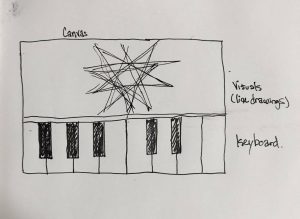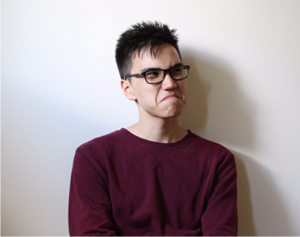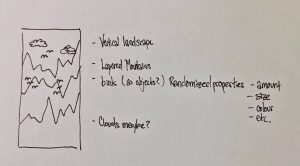I wanted to create an interactive and hopefully addicting mini-game. This project is inspired by the old arcade games I used to spend all my allowance on to win the big prize at the top! Also the final stacked blocks of my project looks similar to a modern skyscraper building in the grey skylines.
//Grace Wanying Hou
//15-104 Section D
//ghou@andrew.cmu.edu
//Final Project
//blocks dimensions setup
var h = 20;
var w = 100;
var x = 0;
var y = 20;
var speed = 1;
var fall = 5;
var dropping = false;
var taps = 0;
//arrays
var blocks = [];
var land = [75];
//gameplay
var play = false;
var gameOver = false;
var win = false;
function setup() {
createCanvas(250, 400);
frameRate(50);
}
function draw(){
noStroke();
if (gameOver == true){
if (play == true){//game screen once "gameover"
makeBackground();
text("YOUR SCORE WAS " + taps, 60, height - h*taps - 2 * h);
text("PRESS ANY KEY TO PLAY AGAIN", 28, height - h * taps - h);
push();
textSize(10);
text("screenshot and share your architecture masterpiece :)", 5, 30)//hehe i like architecture
pop();
updateDisplay();
}
if (win == true){//game screen once player wins
makeBackground();
text("YOU WIN",100,40);
text("PRESS ANY KEY TO PLAY AGAIN", 28, height/2);
push();
textSize(10);
text("screenshot and share your architecture masterpiece :)", 5, 30)
pop();
updateDisplay();
}
//resetting the variables when restarting game
if (keyIsPressed){
gameOver = false;
play = false;
win = false;
blocks = [];
land = [75];
dropping = false;
w = 100;
x = 0;
y = 20;
speed = 1;
fall = 5;
taps = 0;
}
}
else if (play == true){//screen once game starts
makeBackground();
text("PRESS SPACE TO STACK BLOCKS", 30, height/2);
for (var i = 0; i < 3; i++){
var xstart = width / 2 - 50;
var ystart = height - 20;
blocks[i] = makeBlock(xstart, ystart, 100);
}//gameplay functions
blockDrop();
drawBlock();
blockMove();
addBase();
updateDisplay();
scoreDisplay();
}
else {
if (play == false){//starting screen
makeBackground();
text("PRESS ANY KEY TO BEGIN GAME", 28, height/2);
if (keyIsPressed == true){
play = true;
}
}
}
if (w <= 0){
gameOver = true;
play = true;
}
else if (taps >= 16 & y >= 50){
gameOver = true;
win = true;
}
}
function makeBackground(){//making a gradient for the background
strokeWeight(1);
for (var i = 0; i < height; i++){
stroke(255 - i / 8);
line(0, i, width, i);
}
}
function blockMove(){//hovering blocks moving side to side
if (x >= width - w){
speed = -1 - (taps * 0.2);
}
else if(x <= 0){
speed = 1+(taps * 0.2);
}
x = x + speed;
}
function blockDrop(){//dropping blocks
if (dropping == true){
y = y + fall;
speed = 0;
while (y > height - h * taps){
dropping = false;
y = 20;
speed = 1 + (taps * 0.2);
fall = 5;
}
}
}
function keyTyped(){//setting the blocks to drop once space is pressed
if (keyCode == 32 & dropping == false && play == true){
taps = taps + 1;
append(land, x);
dropping = true;
}
}
function drawBlock(){//drawing hovering block
noStroke();
fill(0);
rect(x,y,w,h);
}
function scoreDisplay(){//displaying score (numbers of blocks fallen)
push();
fill(255);
textSize(15);
text(taps,120,height-5);
pop();
}
function addBase(){//knida confusing measurements of blocks collected in the tower
var currenth = height - taps * h - h;//current height of tower
if (y == height - h * taps){//if falling blocks are on the LEFT side of the tower
if (land[taps] <= land[taps - 1]){
blocks.push(makeBlock(land[taps - 1], currenth ,w - (land[taps - 1] - land[taps])));
w = w - (land[taps - 1] - land[taps]);
shorten(land);
append(land, land[taps-1]);
}
else if (land[taps] > land[taps - 1]){//if falling blocks are on the RIGHT side of the tower
blocks.push(makeBlock(land[taps], currenth, w - (land[taps] - land[taps - 1])));
w = w - (land[taps] - land[taps - 1]);
}
}
}
function updateDisplay(){//drawing and updating the display of the stacked blocks
for (var i = 0; i < blocks.length; i++){
blocks[i].add();
}
}
function towerBlocks(){//drawing the blocks in the tower
noStroke();
fill(0);
rect(this.x, this.y, this.bw, this.bh);
}
//objects created for each block in the tower
function makeBlock(xlocation, ylocation, currentwidth){
var block = {x:xlocation,
y:ylocation,
bh:20,
bw:currentwidth,
add:towerBlocks,
}
return block;
}![[OLD FALL 2017] 15-104 • Introduction to Computing for Creative Practice](../../wp-content/uploads/2020/08/stop-banner.png)






